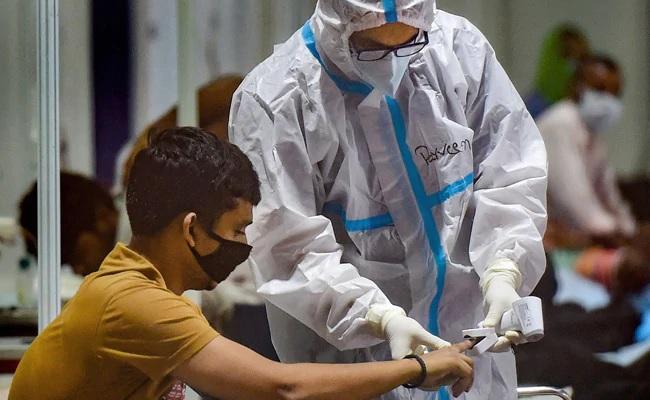COVID-19: Does Stagnation of Fresh Cases Suggest Flattening of the Curve?

Representational image. | Image Courtesy: NDTV
The state of Tamil Nadu remains the second highest number of COVID-19 cases in the country. The number of infections has increased to 6,61,264 till October 12, with 10,314 casualties. The state occupies the second spot, next only to Maharashtra, in the numbers of both total infections and casualties.
In the last 30 days, since September 14, the state has seen unprecedented stagnation in the number of fresh cases, with daily cases remaining between 5,000 and 6,000. While other neighbouring states have reported a spike, as was expected, Tamil Nadu remains an exception.
The continuing stagnation since the end of July has surprised many, as the state has been criticised for poor tracing of primary and secondary contacts. The present unlock relaxations has thrown open public places, except a few tourist destinations, and has given rise to concerns over another round of fresh infections.
STAGNATION IN FRESH CASES
The number of cases in the state has remained highly stagnant during the 30 day period ending October 12. The 4 weeks in the period reported 39,234, 38,815, 39,188 and 41,268 cases respectively. The daily fresh cases never breached the 6,000 mark nor went below 5,000 cases per day, except on October 12, when 4,879 cases were reported.

The state exhibited a relatively flat line on daily fresh cases during the period, compared to severe spikes in Kerala and Karnataka. The consistent numbers of fresh infections is intriguing. The number of daily fresh cases remained between 5516 and 5752 during September 14-20, while the cases remained between 5325 and 5791 in the next seven days. The following two weeks reported further reduction in cases, with the cases reported fluctuating between 5489 and 5688 between September 28 and October 4, and between 4849 and 5447 in the week ending on October 12.
The number of cases in the Greater Chennai Corporation (GCC) also exhibited the same pattern. Though the graph is flattening given the data, it was far from convincing as per experts. The pattern existed from the end of July after the highest single day spike of 6,993 cases was reported on July 27.
‘HERD IMMUNITY IS DEVELOPING’
The reduction in the fresh cases could be a result of the development of herd immunity in the state, particularly in the cities, experts say.
Dr Jayaprakash Muliyil, renowned epidemiologist, told NewsClick, “COVID-19 is an infectious virus and as long as it gets susceptible people, it keeps spreading. Threshold immunity in the society will stop further spread, which is the herd immunity. Places which reported a very high number of cases have hardly any cases now. The slum areas in major cities have developed more immunity than other areas. So, herd immunity is developing.”
As per the first sero survey conducted in Chennai, one-fifth of the city population has been exposed to the viral infection. The 20% exposure cannot be considered to be the threshold for the herd immunity to have developed.
The government has denied the possibility of the community transmission, but the current flattening seems to be the result of the community transmission much earlier in the state.
But, the reliance on herd immunity is being brushed aside by the World Health Organisation (WHO) as unethical. WHO has warned against pursuing the same.
HIGH NUMBER OF DEATHS REMAIN A CONCERN
Though the number of fresh infections has decreased, the continuing casualties remain a cause of concern. The number of total casualties has increased to 10,314 till October 12. The government has claimed to have reduced the mortality rate, but Kerala, which is reporting much higher cases, has a mortality rate of 0.36%.
The Health Minister of the state, Dr Vijaya Baskar, said that the aim of the state government is to bring the mortality rate below 1%, which is presently at 1.36%. With a strong network of public healthcare systems, the government would have had a better chance in reducing the mortality rate. The administrative congestions were cited as the reasons for the high casualties in the state.

The number of asymptomatic cases, recorded at around 86% in June, is also a factor for the high mortality rate. The patients are arriving late in the hospitals, due to lack of proper contract tracing the mortality is higher in the state.
The number of deaths has not decreased in proportion to the daily infections recently. The state was one of the earliest to report a high number of infections, despite which the government failed to strengthen the public healthcare system. The fever clinics and other preventive mechanisms were implemented much later, given the impact of COVID-19 infections in the months of June and July.
REQUIREMENT OF BETTER TRACING MECHANISM
The tracing of primary and secondary contacts of COVID-19 patients has been far from satisfactory in the state.
Dr T Sundararaman, global coordinator of the People’s Health Movement, said, “The curve has flattened in the past two to three months. The flattening of the curve is a much welcome one, but the flattening at a much lower number could have been better for the state.”
The government of Kerala has been listing the cases for whom the source of infection could not be identified, while Tamil Nadu has not made any observations as such. Moreover, the people with symptoms are approaching different testing centres to get themselves testing, leading them being carriers till they receive their results.
“The strengthening of contract tracing could have helped in keeping the threshold at a much lower level. If a better contract tracing was implemented, the cases would have stabilised in the range of thousand per day,” Dr Sundararaman added.
Get the latest reports & analysis with people's perspective on Protests, movements & deep analytical videos, discussions of the current affairs in your Telegram app. Subscribe to NewsClick's Telegram channel & get Real-Time updates on stories, as they get published on our website.
























